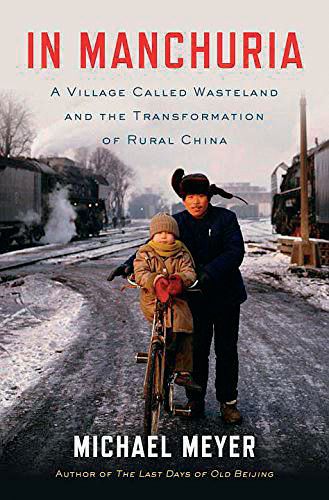
In Manchuria
– A Village Called Wasteland and the Transformation of Rural China
Author: Michael Meyer
Price: US $ 28
Hardcover, 384 pages
Published by Bloomsbury Press
FOREIGNERS who write about China usually live in big cities where the language is easy to understand rather than a slew of dialects from various places, and life there is colorful enough to be seen as a miniature representation of the entirety of China. However, American non-fiction writer Michael Meyer cast his eyes onto the tranquil rural areas – his Chinese wife’s hometown, the northeastern Chinese village named Dahuangdi, meaning a grand wasteland or Wasteland, in Jilin Province, renting a single-story house, sleeping on its heated brick bed, chatting with locals, and teaching English as a volunteer in a nearby primary school. Meyer preferred to travel on the slow “green-skinned” trains passing through those little train stations gradually vanishing due to the tides of time. It took him two years to complete the new book In Manchuria, in which he recorded almost every person he met on this fertile farmland. In his humorous and realistic writing, the characters spring to life vividly on the pages.
A graduate of the University of California at Berkeley, Meyer came to China in 1995 and began to teach English at a small town of Sichuan Province. In 1997, he moved to Beijing and spent a decade in a small alley near Qianmen Street, learning Chinese in Tsinghua University during his spare time. Like Peter Hessler, the author of Country Driving, Meyer successively published his trilogy: The Last Days of Old Beijing: Life in the Vanishing Backstreets of a City Transformed; In Manchuria – A Village Called Wasteland and the Transformation of Rural China; and The Road to Sleeping Dragon: Learning China from the Ground Up.
Meyer has also written for The New York Times, Time magazine, Financial Times, as well as The Wall Street Journal, which earned him numerous awards like the Guggenheim, New York Public Library, Whiting, and Rockefeller Bellagio.
Thanks to Meyer, the Wasteland Village with its 920 households of farmers and the large patches of golden farm-fields has sprung to fame as a new model of the socialist countryside published in The New York Times. The current village is famous for its organic rice and hot spring resort hotel. The old Hongqi Road has been expanded from two to four lanes and a sizeable hospital has also been built up in the village.
The two years Meyer stayed saw radical changes in the village which were all recorded in his book, including the local people’s enthusiasm for reform, and their losses and gains. Meyer treated this small village as an epitome of changing China from a backward mode of production to that of modernity, and thus expanded his interviews to the whole of northeast China, collecting historical relics scattered in those remote villages and absorbing the essence into his writing.
Meyer had a backpack stuffed with notebooks, recording scraps of words or conversations about the weather, farming, people’s automobile brands, their clothes, cuisine, dialects, stories on newspapers, TV broadcasts, and advertisements.
In rural China, the 24 solar terms meant a lot to all inhabitants. Meyer therefore used solar terms to name each chapter of his book. In all the 19 chapters, the name changed from the Winter Solstice to the Great Snow in the next year, forming a cycle of four seasons. Thanks also had to be given to Meyer wife’s uncle who worked hard in farmland throughout his life and told Meyer the secret about the four-season cycle among nature, heaven, and crops.
People’s way of life in this traditional village was also undergoing changes. The village, 28 kilometers away from Jilin City, was then facing the shock of “an integration between village and enterprise.” In 2010, the largest local company – Dongfu Rice contracted nearly all of the 13 square kilometers of farmland and employed and trained farmers to operate polishing and packing machines. The company also planned to transform the village into an enterprise park, while local farmers had to drop out from their farmlands and move into departments. A microcosm of the process of China’s rapid urbanization took shape in Meyer’s book. The elderly in the Wasteland Village also felt a shock at the turning point, not only about their centuries-old life style changing, but also the remaking of their social identity.
Having grown up in the mid-western countryside of Minnesota in the United States where the Mississippi River originates from, the Wasteland Village carried echoes of his hometown for Meyer. In his childhood, he learned a lot about rural areas and agricultural knowledge. Therefore, Meyer enjoyed his journey across the northeast of China, traveling across the meadows, through forests, and crossing rivers. In his eyes, it was one of the most beautiful places of the world.
With different cultural backgrounds but intimacy in human relations, Meyer felt like a fish returning to water again. An emotional connection made northeastern China “charming and unique” in Meyer’s eyes, including the particular accent with the elongated tones, stewed pickled cabbages with potatoes, dumplings with pork stuffing, and the local’s virtue of always being ready to help others – all were so familiar to ones who had experienced the compassion and kindness of Minnesota’s folks.
